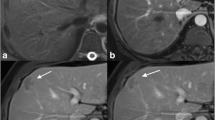Abstract
Purpose
To compare MR imaging features of combined hepatocellular-cholangiocarcinoma (cHCC-CC) in normal, fibrotic, and cirrhotic livers.
Methods
A total of 64 patients with 67 pathologically proven cHCC-CCs were retrospectively analyzed. Patients were classified into three groups according to the patients’ liver condition: patients with normal liver (F0, group 1), fibrosis without cirrhosis (F1–3, group 2), and cirrhosis (F4, group 3). The morphological and MR signal features on T1- and T2-weighted, dynamic contrast-enhanced, diffusion-weighted imaging, as well as the accompanying imaging findings, were evaluated and compared.
Results
There were 12, 19, and 33 patients in groups 1, 2, and 3, respectively. Tumors in the fibrotic and cirrhotic livers were smaller than those in the normal liver, and tumors with cirrhosis had the smallest size (P = 0.0326). No statistical difference was found when comparing the signal intensity on T2-weighted imaging (P = 0.496), but iso- or hypointense lesions were only found in the fibrosis (n = 2) or cirrhosis group (n = 2). Enhancement pattern was different between groups, the washout pattern was more often seen in the cirrhosis group (P = 0.049), and the accompanying mosaic architecture was also more commonly seen in the cirrhosis group (P = 0.048). The ADC values of the lesions were not different among the three groups (P = 0.899).
Conclusion
MRI may provide valuable information for the diagnosis and differential diagnosis of cHCC-CC in normal, fibrotic, and cirrhotic livers. The nodule size, enhancement pattern, and the presence of mosaic architecture in cHCC-CC differ between different degrees of background liver disease.









Similar content being viewed by others
References
O’Connor K, Walsh JC, Schaeffer DF (2014) Combined hepatocellular-cholangiocarcinoma (cHCC-CC): a distinct entity. Ann Hepatol 13:317–322
Yeh MM (2010) Pathology of combined hepatocellular-cholangiocarcinoma. J Gastroenterol Hepatol 25:1485–1492
Park H, Choi KH, Choi S-B, et al. (2011) Clinicopathological characteristics in combined hepatocellular-cholangiocarcinoma: a single center study in Korea. Yonsei Med J 52:753–760
Kim SH, Park YN, Lim JH, et al. (2014) Characteristics of combined hepatocellular-cholangiocarcinoma and comparison with intrahepatic cholangiocarcinoma. Eur J Surg Oncol 40:976–981
Shetty AS, Fowler KJ, Brunt EM, et al. (2014) Combined hepatocellular-cholangiocarcinoma: what the radiologist needs to know about biphenotypic liver carcinoma. Abdom Imaging 39:310–322
Yin X, Zhang B-H, Qiu S-J, et al. (2012) Combined hepatocellular carcinoma and cholangiocarcinoma: clinical features, treatment modalities, and prognosis. Ann Surg Oncol 19:2869–2876
Garancini M, Goffredo P, Pagni F, et al. (2014) Combined hepatocellular-cholangiocarcinoma: a population-level analysis of an uncommon primary liver tumor. Liver Transplant 20:952–959
Ikeda H, Harada K, Sato Y, et al. (2013) Clinicopathologic significance of combined hepatocellular-cholangiocarcinoma with stem cell subtype components with reference to the expression of putative stem cell markers. Am J Clin Pathol 140:329–340
Lee SD, Park S-J, Han S-S, et al. (2014) Clinicopathological features and prognosis of combined hepatocellular carcinoma and cholangiocarcinoma after surgery. Hepatobiliary Pancreat Dis Int 13:594–601
Potretzke TA, Tan BR, Doyle MB, et al. (2016) Imaging features of biphenotypic primary liver carcinoma (hepatocholangiocarcinoma) and the potential to mimic hepatocellular carcinoma: LI-RADS analysis of CT and MRI features in 81 cases. AJR Am J Roentgenol 11:1–7
Chu K-j Lu, C-d Dong H, X-h Fu, H-w Zhang, X-p Yao (2014) Hepatitis B virus-related combined hepatocellular-cholangiocarcinoma: clinicopathological and prognostic analysis of 390 cases. Eur J Gastroenterol Hepatol 26:192–199
Razumilava N, Gores GJ (2014) Liver transplantation for intrahepatic cholangiocarcinoma—Authors’ reply. Lancet 384:1182–1183
Wells ML, Venkatesh SK, Chandan VS, et al. (2015) Biphenotypic hepatic tumors: imaging findings and review of literature. Abdom Imaging 40:2293–2305
de Campos ROP, Semelka RC, Azevedo RM, et al. (2012) Combined hepatocellular carcinoma-cholangiocarcinoma: report of MR appearance in eleven patients. J Magn Reson Imaging 36:1139–1147
Truant S, Boleslawski E, Duhamel A, et al. (2012) Tumor size of hepatocellular carcinoma in noncirrhotic liver: a controversial predictive factor for outcome after resection. Eur J Surg Oncol 38:1189–1196
Bedossa P, Poynard T (1996) An algorithm for the grading of activity in chronic hepatitis C. Hepatology 24:289–293
Landis JR, Koch GG (1977) Measurement of observer agreement for categorical data. Biometrics 33:159–174
Fowler KJ, Sheybani A, Parker RA III, et al. (2013) Combined hepatocellular and cholangiocarcinoma (biphenotypic) tumors: imaging features and diagnostic accuracy of contrast-enhanced CT and MRI. AJR Am J Roentgenol 201:332–339
Rimola J, Forner A, Reig M, et al. (2009) Cholangiocarcinoma in cirrhosis: absence of contrast washout in delayed phases by magnetic resonance imaging avoids misdiagnosis of hepatocellular carcinoma. Hepatology 50:791–798
Gupta AA, Kim DC, Krinsky GA, Lee VS (2004) CT and MRI of cirrhosis and its mimics. AJR Am J Roentgenol 183:1595–1601
Schelhorn J, Best J, Reinboldt MP, et al. (2015) Does diffusion-weighted imaging improve therapy response evaluation in patients with hepatocellular carcinoma after radioembolization? Comparison of MRI using Gd-EOB-DTPA with and without DWI. J Magn Reson Imaging 42:818–827
Acknowledgments
This study was funded by the National Natural Science Foundation of China (Grant Number 81571661), the Shanghai Sailing Program (Grant Number 16YF1410600), and the Youth Science Foundation of Zhongshan Hospital, Fudan University (Grant Number 2015ZSQN14).
Author information
Authors and Affiliations
Corresponding author
Ethics declarations
Conflict of interest
Ruo Fan Sheng, Yan Hong Xie, Yuan Ji, Cai Zhong Chen, Li Yang, Kai Pu Jin, and Meng Su Zeng declare that they have no conflict of interest.
Ethical approval
All procedures performed in studies involving human participants were in accordance with the ethical standards of the institutional and/or national research committee and with the 1964 Helsinki declaration and its later amendments or comparable ethical standards.
Informed consent
This retrospective study was approved by the institutional review board and informed consent was waived.
Rights and permissions
About this article
Cite this article
Sheng, R.F., Xie, Y.H., Ji, Y. et al. MR comparative study of combined hepatocellular-cholangiocarcinoma in normal, fibrotic, and cirrhotic livers. Abdom Radiol 41, 2102–2114 (2016). https://doi.org/10.1007/s00261-016-0811-y
Published:
Issue Date:
DOI: https://doi.org/10.1007/s00261-016-0811-y




